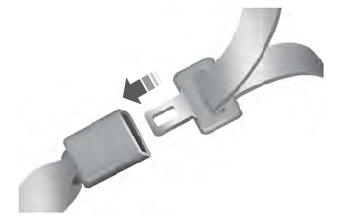Ford Escape: Fuel Charging and Controls - Turbocharger - 1.5L EcoBoost (132kW/180PS) – I3 (Y1) / Description and Operation - Turbocharger - System Operation and Component Description
System Operation
Turbocharger And Charge Air Cooler (CAC) Systems
Turbocharger System
A turbocharger is an exhaust gas driven device used to increase the power output of an engine by the turbocharger compressor increasing the pressure of the air entering the engine. The turbocharger uses exhaust gas energy to drive the turbine connected to the compressor. Compressing the air causes the temperature to increase. The CAC lowers the temperature of compressed air which increases the density of the air before entering the cylinder.
The wastegate on the turbocharger turbine side is opened to reduce exhaust gas flow through the turbine when boost pressure is not needed. A pneumatic actuator controls the wastegate valve opening. The turbocharger wastegate is controlled by the PCM by a PWM signal to the turbocharger wastegate regulating valve solenoid.
The pneumatic wastegate is vacuum actuated, and the poppet style wastegate valve is normally opened at idle or low engine airflow conditions depending on vehicle configuration and requirements such as fuel economy and boost performance. The turbocharger wastegate regulating valve solenoid supplies vacuum to the wastegate actuator to close the poppet style wastegate valve.
The 3 cylinder system uses only 1 turbocharger and 1 turbocharger wastegate.
Charge Air Cooler (CAC) System — Air To Air Cooled
The CAC system cools the intake air which has been heated by the turbocharger. The removal of heat from the pressurized air going into the CAC increases the air density which improves combustion efficiency, engine horsepower, and torque. The system consists of a CAC radiator in the grille and tubing to interconnect these components. The CAC is positioned after the turbocharger directly in the flow of the intake air. As the heated air flows through the CAC , it is cooled by the airflow through the grille. The PCM maintains a desirable intake air temperature by monitoring the MAP / IAT2 (located at the intake manifold) sensor.
Component Description
Turbocharger
The turbocharger assembly is an exhaust driven centrifugal compressor. Expanding exhaust gases drive the turbine shaft assembly to speeds over 100,000 RPM . The turbocharger increases the power output of an engine by increasing the mass of air entering the engine.
The turbocharger has an integrated wastegate.
Turbocharger Wastegate Regulating Valve Solenoid
The turbocharger wastegate regulating valve solenoid allows the PCM to control the turbocharger wastegate position. The turbocharger wastegate regulating valve solenoid controls the vacuum supplied to the pneumatically actuated wastegate diaphragm in order to control the boost pressure limit. When the compressor outlet pressure increases, a pneumatically powered actuator opens the turbocharger wastegate and limits the compressor outlet pressure. The turbocharger wastegate regulating valve solenoid supplies vacuum to the pneumatically actuated wastegate canister diaphragm, which regulates the boost pressure to the desired value.
For the normally open vacuum actuated turbocharger wastegate, the turbocharger wastegate regulating valve solenoid controls vacuum applied to the turbocharger wastegate actuator. The amount of vacuum applied to the turbocharger wastegate actuator allows the PCM to control the boost pressure. To generate maximum boost pressure, the PCM controls the turbocharger wastegate regulating valve solenoid to apply full vacuum to the turbocharger wastegate actuator. Boost pressure levels are controlled by regulating vacuum to the wastegate actuator. The spring pressure in the turbocharger wastegate actuator defaults the turbocharger wastegate to a fully open position.
 Description and Operation - Turbocharger - Component Location
Description and Operation - Turbocharger - Component Location
1.5L EcoBoost Turbocharger Components
Item
Description
1
Turbocharger
2
Turbocharger oil supply tube
3
Turbocharger oil return tube
4
Turbocharger coolant supply tube
5
Turbocharger coolant return tube
6
Wastegate control valve solenoid
1...
 Diagnosis and Testing - Turbocharger Controls
Diagnosis and Testing - Turbocharger Controls
Diagnostic Trouble Code (DTC) Chart
Diagnostics in this manual assume a certain skill level and knowledge of Ford-specific diagnostic practices. REFER to: Diagnostic Methods (100-00 General Information, Description and Operation)...
Other information:
Ford Escape 2020-2025 Owners Manual: Sitting in the Correct Position
When you use them properly, the seat, head restraint, seatbelt and airbags will provide optimum protection in the event of a crash. We recommend that you follow these guidelines: Sit in an upright position with the base of your spine as far back as possible...
Ford Escape 2020-2025 Owners Manual: Cruise Control
What Is Cruise Control Cruise control lets you maintain a set speed without keeping your foot on the accelerator pedal. Requirements Use cruise control when the vehicle speed is greater than 20 mph (30 km/h). Switching Cruise Control On and Off WARNING: Do not use cruise control on winding roads, in heavy traffic or when the road surface is slippery...
Categories
- Manuals Home
- 4th Generation Ford Escape Owners Manual
- 4th Generation Ford Escape Service Manual
- Drive Modes
- Opening and Closing the Hood
- Switching the Lane Keeping System On and Off. Switching the Lane Keeping System Mode. Alert Mode
- New on site
- Most important about car
Fastening the Seatbelts

